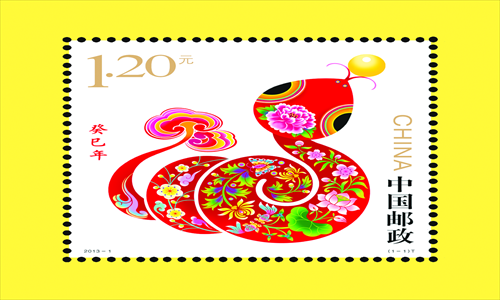Coiled cutie


China Post's new zodiac stamp hisses history and flicks festivity
An image search on the word "cold-blooded" pulls up a lot of pictures of snakes. And few people live without a healthy level of fear for this species that is regarded as dangerous and sometimes life-threatening. But as China's Lunar New Year approaches, folks are hoping the cute side of the animal will prevail and bring about an auspicious year for all.
Early this month, China Post published its zodiac animal stamp for 2013, China's Year of the Snake. The stamp, which features an agile and lovely red snake covered with beautiful flowers, has won much applause for its delightful design and its reflection of traditional Chinese culture. The price, with a face value of 1.2 yuan ($0.19), soared to more than 10 times that within several days.
Wu Guanying, the designer of the stamp, told the Global Times that the snake is the most difficult to design among the 12 zodiac animals. "I listened to other experts' suggestion in designing the snake, trying to make it appear festive and auspicious to celebrate the New Year."
Auspicious omen
On the stamp is a red chubby snake spiraling in circles and looking up, with its mouth pouting and a pearl above. The design is a combination of ancient myths and elements in traditional Chinese culture.
According to Wu, who is a professor at Tsinghua University, the idea of the pearl is from an ancient story that says "a snake holding a bright pearl means to pay a debt of gratitude." It stresses the Chinese traditional virtues of philanthropy and gratitude. The tail of the snake divides into two parts to signal safety and health.
The color of the snake is red because, as Wu explained, a red snake is highly auspicious. There are five kinds of flowers over the body of the snake, including peach blossoms for spring, lotus flowers for summer, chrysanthemum in autumn and plum blossom to show the harmony and the auspicious sign of the four seasons. It also includes peony to reflect Chinese character.
Xu Kai, a senior stamp collector, said he was impressed by the rich content of Chinese traditional culture and the cute design. "The design is cartoonized and lovely," Xu told the Global Times, "particularly in comparison with the realistic painting of zodiac animal stamps from other countries, which look horrible."
Wu told the Global Times that he embarked on the design since last April and May and has produced five versions of the stamp in total. "The stamp should embody auspice and jollity, which is the main guiding theory, but there are different languages to express it," Wu said.
"They picked this one probably because it expresses the auspice and festive mood the most," he said. He has revised his designs several times amid the evaluation of experts invited by China Post.
"It is a big challenge," said Wu, "The snake is more difficult to design compared to other zodiac animals because of its long shape and there is little to exploit about its colors." He added that the snake attracts much less attention and is a zodiac animal of small popularity.
Festive atmosphere
Since 1980 when China issued its first zodiac animal stamp, China has issued over two rounds of such stamps in the past 32 years. Besides their popularity among collectors, the zodiac animal stamps have become a cultural symbol that adds to the festive atmosphere of China's celebration of the Lunar New Year.
According to Yan Bingwu, director of the editing and design department of the Postage Stamp Printing Bureau, China Post recruits from artists and designers nationwide every year for good ideas. "These artists are mostly artists from art institutes and universities that are specialized in designing and decorative art," he told the Global Times. The bureau invites over 10 artists annually and sometimes chooses artists based on the nature of different animals.
Yan said that there is no specific standard, but since the stamp is for the traditional New Year and for the public to enjoy, they should appear auspicious. "Some designs are artistically outstanding, but we have to give up on them because they don't create a festive atmosphere," he said.
"The designers should have a deep understanding of Chinese culture and demonstrate it in accordance with Chinese people's festive mood and wishes for the New Year," Wu said. He is also the designer for 2011's rabbit stamp and one designer for the 2008 Beijing Olympic Games' mascot Fuwa.
Reflecting back on the zodiac stamps, one can easily notice that all of them feature distinct Chinese cultural elements, such as the auspicious cloud, paper-cut and multicolor cloth.
"The design first of all should be easily recognized as Chinese in the style, content and the color," said Wu, "Also, since it is for all Chinese people, they need to meet the demands of people of different ages aesthetically."
But he added that different designers' styles vary in expressing the festive atmosphere of the zodiac animal. Last year, the dragon stamp aroused much controversy due to the fierce image of the dragon. Some thought it was inconsistent with the spirit of Spring Festival.
But to Wu, it is natural. "Unlike the snake, the dragon itself is aggressive and exaggerated," he said.
Innovative consideration
Amid the popularity of the snake stamp, some also doubt that the design of zodiac animal stamps has fallen into a set mode of paper-cut and multicolor cloth. Yan said they are considering how to innovate the stamps now as zodiac animal stamps have undergone almost three rounds (36 years) already. He said discussions were ongoing about the 4th round of stamps, striving for a new look.
While only designers are included for the design of zodiac stamps, Yan revealed to the Global Times that they are thinking of taking suggestions from the public. "It is for the people and we should consider their opinion," he said.
Innovation is important, but since it is a traditional symbol, innovation should not go too far, according to Wu. He said he balanced innovation with tradition in his design.
The zodiac animals, which originated in China 2,000 years ago, have been an inseparable part of Chinese culture. Besides China, other countries in the Southeast Asia and countries with large Chinese populations also issue zodiac animal stamps.
Following China's snake stamp, countries like Canada, Australia, Lithuania and North Korea have also published their stamps for the snake year recently. The stamps around the world are designed either by Chinese stamp designers or their own designers or agents.
"Some stamps are designed by Western designers who cannot understand the importance of zodiac animal culture for Chinese people," said Wu, "Their designs are too realistic and blunt in showing the animals, lacking the festive atmosphere and auspicious implications people desire.